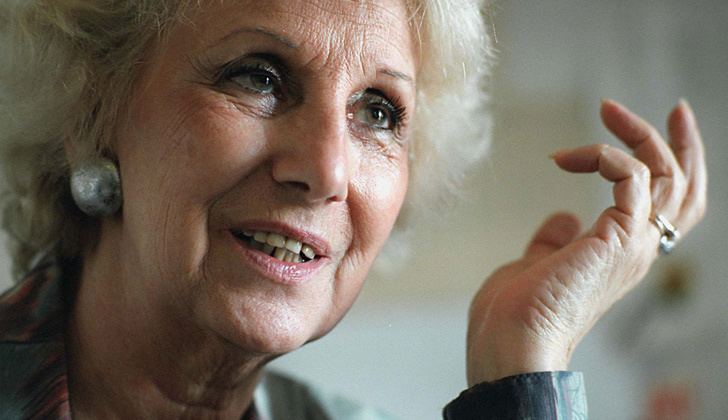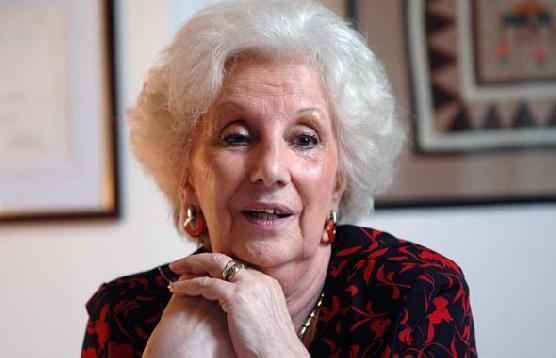Name Estela de Grandchildren Ignacio Hurban | Role Human rights activists | |
 | ||
Spouse Guido Carlotto (m. ?–2001) Children Laura Carlotto, Claudia Carlotto, Miguel Guido Carlotto Similar People Ignacio Hurban, Hebe de Bonafini, Maria Romilda Servini d, Jorge Rafael Videla, Cristina Fernandez de Kirchner | ||
Estela de carlotto en el buscador en red completo
Enriqueta Estela Barnes de Carlotto (Buenos Aires, born October 22, 1930) is an Argentine human rights activist and president of the association of Grandmothers of the Plaza de Mayo. One of her daughters, Laura Estela Carlotto, was kidnapped and missing while pregnant in Buenos Aires, in late 1977. Through stories, she could ascertain that her daughter had given birth to a boy, and that her grandson was appropriated and his identity changed. She searched for him for nearly 36 years, until, on August 5, 2014, after a DNA check voluntarily made by the person concerned, her grandson was identified, and became the 114th in the list of recovered grandchildren.
Contents
- Estela de carlotto en el buscador en red completo
- Estela de carlotto ahora est completa la familia morfi
- Biography
- Activism
- References

Carlotto has received several awards for her work with Grandmothers of the Plaza de Mayo (Abuelas de Plaza de Mayo), including the United Nations Prize in the Field of Human Rights and Félix Houphouët-Boigny Peace Prize, awarded by the Unesco.

Estela de carlotto ahora est completa la familia morfi
Biography

Enriqueta Estela Barnes was born on October 22, 1930, in Buenos Aires, within a family of English descent. She married Guido Carlotto, an industrial labourer of Italian descent, with whom she had four children. She was an elementary school teacher and a housewife without no public action.

In the 1970s, when ruled the country the civil-military dictatorship self-appointed National Reorganization Process (1976-1983), three of her children were involved in politics: Laura Estela, a student of History at the National University of La Plata, militated in the Peronism, Claudia belonged to the Peronist University Youth and Guido Miguel integrated the student center of his high school. on August 5, 1977, the armed forces kidnapped and tortured her husband, who was freed after payment of 40 million pesos (equivalent to 30 000 dollars at that time).
In late November 1977, Laura, three months pregnant, was kidnapped and taken to clandestine detention center La Cacha in La Plata, until the end of August 1978. Shortly before the childbirth, was taken to an unspecified location -there disputes on which place-, which gave birth on June 26, 1978. Some testimonies collected before realized that that place could have been the Military Hospital in Buenos Aires. But from the restoration of the true identity of her child, there are strong suspicions that the baby could have been born in the vicinity of La Cacha or in a hospital in the province of Buenos Aires.

Carlotto made arrangements for the freedom of her daughter, and came to meet with the general Reynaldo Bignone, who told her that Laura would not stay alive. In April 1978, a companion of captivity of her daughter, who had been freed, informed her that Laura was still alive and pregnant.
Laura sent us to say that fed her a little better and that the baby would be born in June of that year, and if was a boy they would call Guido, like his dad. And that i search for the orphanage
Carlotto and her family always called Guido to the baby, because that was the name that wanted to put the mother.
In April 1978, Carlotto began to participate in the activities of Grandmothers of the Plaza de Mayo. On August 25 of that year, she was summoned by the military and was handed her the dead body of her daughter, who was buried in La Plata two days later. It was one of the few cases where a missing body was returned to his family. Carlotto retired on August 30
Activism
Retired from her post as principal since August 30, 1978, Mrs. Carlotto became a member of the Abuelas Argentinas con Nietitos Desaparecidos (Argentine Grandmothers with Missing Grandchildren) by April 1979. She then began to seek and demand the release of her grandson and other children kidnapped or disappeared by military forces during the military dictatorship. The group, founded by Alicia de la Cuadra and 11 other grandmothers in a similar situation in 1977, was renamed the Association of Grandmothers of Plaza de Mayo in 1980. Mrs. Carlotto became its Vice President, and in 1989 its President.
Her search for information led her to São Paulo, Brazil, in 1980, where women whose children and/or grandchildren had met similar fates had organized CLAMOR, a group dedicated to raising public awareness of ongoing abuses. While in São Paulo, she was told by a La Cacha prison survivor of a woman known as "Rita" whose father owned a paint store, had had a baby boy, and was released with "Carlos" on August 24, 1978. The anecdote led Mrs. Carlotto to believe that her daughter had been killed upon her release.
An estimated 500 children were either kidnapped or seized at birth from women in detention during the Dirty War. The vast majority were given or sold to adoptive parents, including numerous perpetrators and accomplices in the murder of their biological parents. The Grandmothers of Plaza de Mayo located the first missing grandchild in 1984. They secured the establishment of the National Genetic Data Bank for Relatives of Disappeared Children in 1987, and the National Commission for the Right of Identity, an office tasked with facilitating answers to those who doubt the nature of their adoptions, in 1992. Mrs. Carlotto announced the discovery of the 100th grandchild on December 21, 2009.
Guido Carlotto, her husband, died in La Plata on October 21, 2001. Estela Barnes de Carlotto earned the United Nations Prize in the Field of Human Rights in 2003. She was on hand with President Cristina Fernández de Kirchner to inaugurate the Jardin des Mères et Grand-mères de la Place de Mai in Paris, in 2008. Filmmaker Nicolás Gil Lavedra began production on a biographical film, Estela, in 2011, starring Susú Pecoraro as the renowned activist.
Mrs. Carlotto announced on August 5, 2014, that her long-lost grandson had been discovered after he voluntarily came forward for a DNA test. Her grandson, named Ignacio Hurban, leads a jazz orchestra and directs the Rossi Brothers School of Music in Olavarría; he thus became the 114th grandchild to have his true identity discovered by the Grandmothers of the Plaza de Mayo. Shortly after his public appearance, Hurban changed his name to Ignacio Guido Montoya Carlotto.
